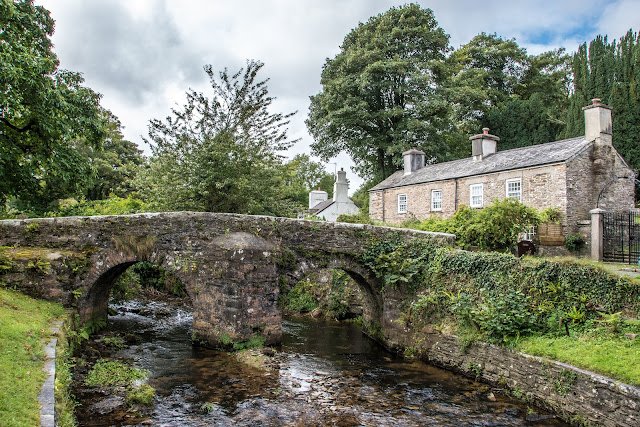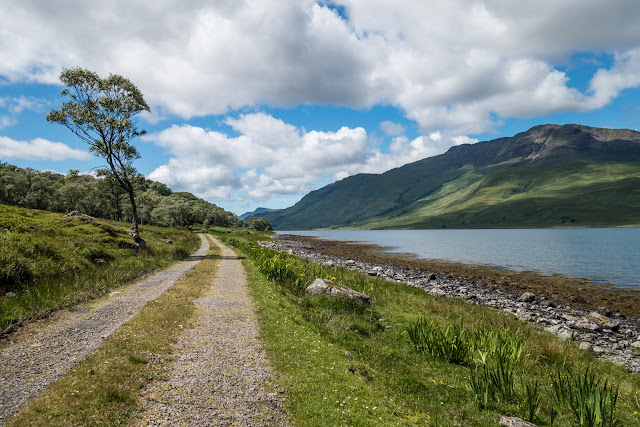The Edge of Bodmin
There were a few places that we had earmarked for today and the first ones were really just plucked from the map - `Picturesque village.` Well, we had to have a look at that one!
The village in question, on the edge of Bodmin, was Altarnum which had this wonderful packhorse bridge, and a magnificent church, perched at the top of the village. Well worth a visit.
A packhorse bridge is a bridge intended to carry pack horses (horses loaded with side bags or panniers) across a river or stream. Typically a packhorse bridge consists of one or more narrow (one horse wide) masonry arches, and has low parapets so as not to interfere with the horse's panniers. Multi-arched examples sometimes have triangular cutwaters that are extended upwards to form pedestrian refuges.
Packhorse bridges were often built on the trade routes (often called packhorse routes) that formed major transport arteries across Europe and Great Britain until the coming of the turnpike roads and canals in the 18th century. Before the road-building efforts of Napoleon, all crossings of the Alps were on packhorse trails. Travellers' carriages were dismantled and transported over the mountain passes by ponies and mule trains.
The village is dominated by the 15th C church of St Nonna (strange!) Measuring the tower height from the ground to the top of the pinnacles is over 100ft!
From Altarnum it was a short hop across to the next village whose claim to fame is regarding a certain John Wesley. He was was an Anglican cleric and theologian who, with his brother Charles and fellow cleric George Whitefield, founded Methodism. Throughout his life, Wesley remained within the established Anglican church, insisting that the Methodist movement lay well within its tradition. In his early ministry, Wesley was barred from preaching in many parish churches and the Methodists were persecuted; he later became widely respected and, by the end of his life, had been described as "the best loved man in England"
The cottage looks like a million others in Cornwall but its fame lies in the following story: On their first trip to Cornwall with John Wesley in 1743, two of his companions, John Nelson and John Downes, stopped at stonemason Digory Isbell's cottage to seek hospitality.
They were welcomed by his wife, Elizabeth. Nelson called again as he was leaving Cornwall and reportedly preached to some 300 people.
After that Wesley was also a regular lodger, and so Digory Isbell added a two-room 'Prophet's Chamber' to his cottage where Wesley and his preachers both stayed and preached.
The lower room of the Chamber is thought to be the smallest Methodist preaching place in the world.
In the garden can be seen the following Biblical text.
And of course, the plaque on the wall for the tourists - (us!)
Bodmin is a great place for wind, and this wind turbine looked good against the beautiful sky.
On leaving John Wesley behind we made our way toward Bolventor, the site of Jamaica Inn. This I was looking forward to seeing, as one of my favourite books is Daphne du Maurier's 1936 novel Jamaica Inn. I had an image in my mind of an inn deep in Bodmin Moor, isolated and wild. What a contrast to reality!
Today it is on a main road and is a very busy place. It is, to be true an 18th century Inn, and the surrounding moorland is bleak, but the illusion is shattered!
One of the best bits was the sign showing a smuggler, an occupation described in the book and once widespread in that area.
That evening we were going to drive to Crackington Haven, but somehow took a wrong turning. After some twisty turns and a very scary descent we arrived at this charming bay called Millook.
My first image (above) was of an old boat leaning against a shed, just catching the last of the sun.
As the sun dipped, the sky and beach were bathed in a beautiful light. I guess this isolated spot would be less secluded in daytime, but tonight, except for three young people (below) wandering past magnificent cliffs, we were on our own. The sunset (above) was the best view of the evening but all in all, a beautiful spot - if you can stand the descent!!
The beautiful patterns of the cliff structures















Comments